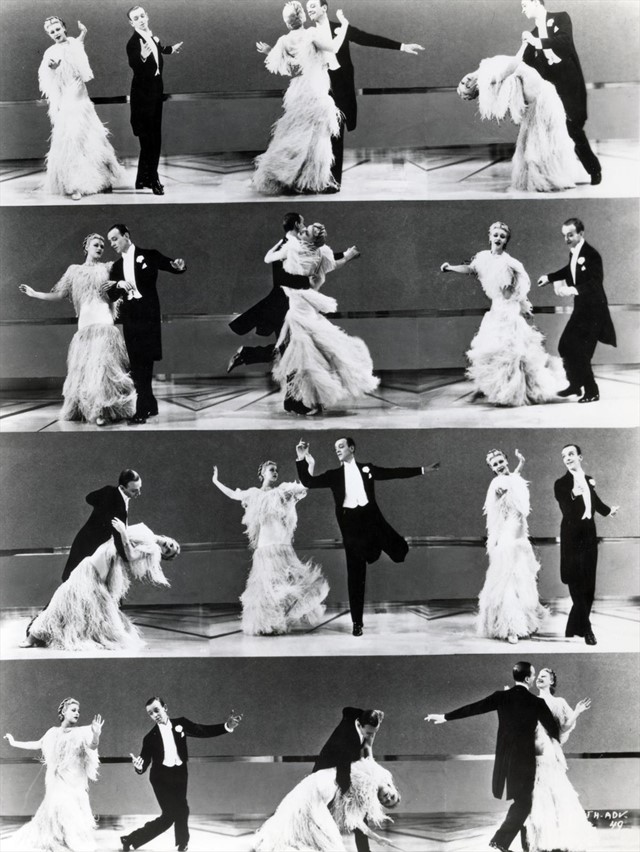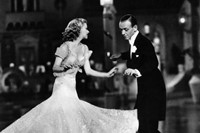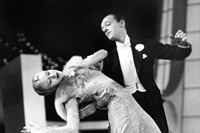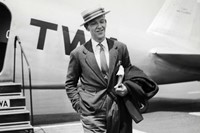AnOther look back to the 1930s for a lesson in elegance
Many refer to the 1930s as a grim decade: opening with the Wall Street Crash, it played host to the Great Depression, and the global anxieties in the run up to the Second World War. And, as often happens in a time of crisis, people turned to clothing for escapism. It was said by Alexander McQueen and many others before him, that we often look to our clothing as a means of protection, comfort and diversion. Elegance in an Age of Crisis by Patricia Mears and Bruce Boyer details this period and the important sartorial changes that took place during the decade. The 1930s may have been a time of worry, but it also saw the arrival of Schiaparelli, Charles James, Vionnet and the development of Savile Row. Nestled between the Jazz Era and the War, it was a time of romanticism, femininity and new tailoring for men that was heavily influenced by the cinema. Here AnOther break down ten codes of elegance.
1. Ginger Rogers
Ginger Rogers and Fred Astaire danced their way through much of the 1930s in films including Top Hat (1935), The Gay Divorcee (1934) and Swing Time (1936). Rogers wore sequins, ostrich feathers and billowing, fluid sleeves and skirts and was the epitome of cinematic glamour. "I believe in dressing for the occasion," she said. "There’s a time for a sweater, sneakers and Levis and a time for the full-dress jazz."
2. Bustlines
After a decade of being repressed, fashion celebrated the bust again. This was complimented by fitted sleeves and nipped waists, celebrating the female form. The style was popularised by Hollywood starlets including Rita Hayworth, Greta Garbo and Marlene Dietrich.
3. Madeleine Vionnet
Vionnet created a stir during the 1920s for her bias-cut designs and sleek drapery. Inspired by Greek statues, these streamline, flowing dresses would define the silhouette for the 1930s, pioneering Classicism. She used crepe de chine, gabardine and satin, all of which were very unusual for the time. “The dress must not hang on the body but follow its lines,” she instructed. “When a woman smiles, the dress must smile with her.”
4. Bette Davis
Often referred to as the First Lady of American Cinema, Bette Davis shaped Hollywood in the 1930s. She refused to comply with Hollywood ideals of the time, championing her unconventional beauty and realism, and was utterly sexy in doing so. With her big doe eyes and blonde curls, she played a succession of anguished, neurotic, powerful female characters which led the way for headstrong females onscreen. She approached fashion with a demure simplicity and once said, “I often think that a slightly exposed shoulder emerging from a long satin nightgown packs more sex than two naked bodies in bed.”
"There’s a time for a sweater, sneakers and Levis and a time for the full-dress jazz." — Ginger Rogers
5. Elsa Schiaparelli
Schiaparelli began designing in the late 1920s but really came into her own at the turn of the decade. A true nonconformist, she is famed for her daring and innovative approach to clothing and considered the first designer to combine art and fashion. Along with close contemporaries Salvador Dali and Alberto Giacometti, she played a key role in the Surrealist movement. She designed the Shoe Hat (1937), The Lobster Dress (1937) and thrust “Shocking Pink” into the mainstream, as well as being one of the first designers to feature exposed zips. Her trompe-l'oeil white bow jumper was also a hallmark for style in the 1930s. She maintained a friendly rivalry with Coco Chanel throughout the decade, referring to her as simply “the milliner”.
6. Savile Row
It was during the 1930s that the standard suit silhouette was established for men. The ‘London-cut’ suit was developed by Frederick Scholte, which featured squared shoulders and a broad torso, adopted by onscreen stars including Fred Astaire and Cary Grant. In 1934, Clark Gable removed his shirt in It Happened One Night to reveal a bare torso, marking the immediate decline of the undershirt.

7. Jean Harlow
Noted for her feathered negligee and satin gowns, Harlow predated Marilyn Munroe as the silver screen's blonde bombshell. Films including Red Headed Women (1932) and Dinner at Eight (1933) made her one of Hollywood's greatest stars. She bleached her hair weekly, which the media blamed for when she died of suddenly of renal failure at just 26. Perhaps it is the fact that she has never aged, permanently locked in the 1930s, that has made Harlow one of the decade's greatest vintage pin-ups, forever poised in a sequin gown on the edges of stardom.
8. Augustabernard Couture
Augusta Bernard was one of the first female couturiers to dominate Paris between the first and second world war. Advocating the Classicism ethos of the era, her designs, under the name Augustabernard, pioneered fabric manipulation and geometric precision. Sadly, while her talent was recognised, she never achieved the following of Vionnet or Chanel, largely due to her refusal to partake in marketing and advertising. A couturier she was but sadly a businesswoman she was not, and her house was forced to close in 1934. Vogue editor Bettina Ballard wrote, “She created beautiful clothes but sadly forgot to collect her bills.”
9. The Swimsuit
Until the 1930s, the swimsuit had been a two-piece outfit for both sexes. With each passing year of the decade, more flesh was revealed and scratchy wool was replaced by new synthetic fabrics. Mabs of Hollywood began to design swimsuits using Lastex, which Marlene Dietrich ordered in every colour, sounding the death knell of the knitted swimsuit forever.
10. Mobsters
It would be impossible to reference 1930s glamour and style without tipping a hat to the gangster mob-style of the decade. Championed by characters such as Al Capone and Bugsy Siegel, the men wore bold pinstripe and checked custom-made suits with raccoon coats, wide-brimmed hats and jewellery, while their better halves dressed in feathers and sequins, a play on Hollywood Glamour.
Elegance in an Age of Crisis is out now, published by Yale University Press.



